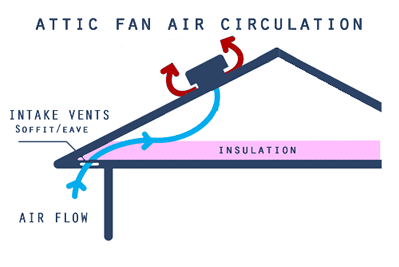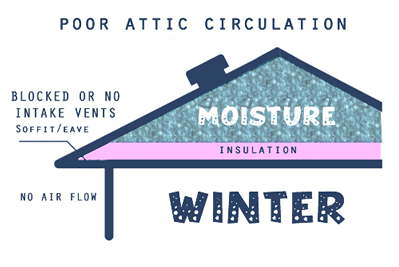ATTIC VENTILATION IS IMPORTANT
It may seem counter-intuitive to add insulation for warmth and then purposely allow cool air to enter the attic through vents, but this combination is the key to a durable and energy-efficient home.
HERE’S WHY
In winter, allowing a natural flow of outdoor air to ventilate your attic helps keep it cool, which reduces the potential for moisture build up and ultimately ice damming (snow that melts off a roof from an attic that is too warm and then re-freezes at the gutters, causing an ice dam that can damage the roof).
INTAKE & EXHAUST VENTING
Air intake and exhaust vents are used in ventilating steep-slope roof assemblies to provide a means of allowing outside air to enter and exit attics and ventilation spaces. Air intake vents are used to allow outside air to enter into attics and ventilation spaces. Intake vents should be located at or near soffits or eaves. Intake vents are best used with exhaust vents that are located higher up near the roof peak. This configuration of ventilation air intake along low points and exhaust at high points takes advantage of natural convection.
There are a variety of attic exhaust options, the most common include roof vents and attic fans or a combination of both depending on the size of the attic space.
COMMON VENTILATION PROBLEMS
Blocked or covered intake vents can dramatically reduce the amount of air flow through your attic. Many homes in the area appear to have soffit or eave vents, but when the vent screens are removed intake holes are blocked or non-existant.
OPENING BLOCKED VENTS
We can open up intake vents and install proper baffles to ensure air flows into your attic. This is an affordable project the can dramatically improve air circulation in your attic.
NOT SURE WHAT YOU NEED?
Not sure what venting you have in your attic? Call us for a ventilation assessment today!





